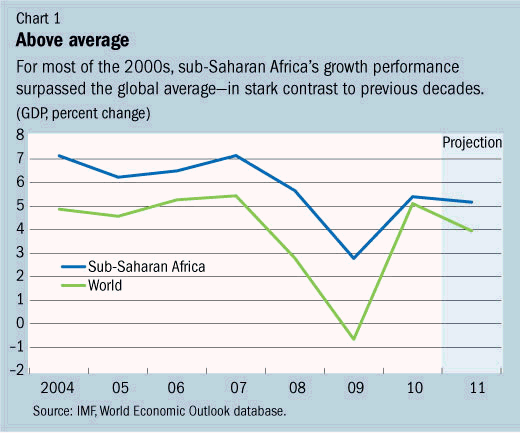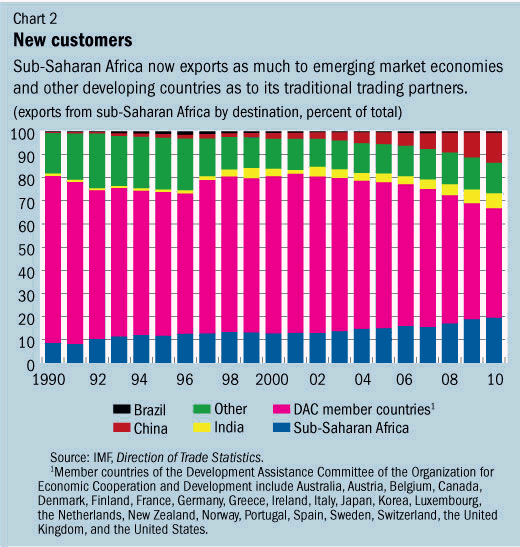
Typical street scene in Santa Ana, El Salvador. (Photo: iStock)
IMF Survey: Odds in Africa's Favor as Continent Walks Economic Tightrope
January 10, 2012
- Most sub-Saharan African economies enter 2012 in relatively good shape
- But weak global growth, financial turbulence present severe downside risks
- For now, authorities should keep to current cautious policy paths
The big question for sub-Saharan Africa in 2012 is whether the region can sustain its recent strong growth in the face of a stalling global economy.

Fishing fleet prepares to embark in Cape Coast, Ghana: good policies have allowed Africa’s increasingly robust private sectors to thrive (photo: Finbarr O’Reilly/Reuters)
AFRICA IN 2012
For now, the odds seem to be in its favor. But the costs of a fall from the region’s tightrope performance of 2011 remain disconcertingly high.
In 2011, against a threatening global backdrop, most economies in sub-Saharan Africa turned in a solid performance. Growth averaged more than 5 percent and export shares stayed high. Nevertheless, specific shocks hit hard, particularly the drought in the Horn of Africa and the spike in global food and fuel prices. In parts of eastern Africa, the re-emergence of inflation presented a new macroeconomic challenge.
Sub-Saharan Africa had also proved reassuringly resilient to the global financial crisis in 2008–09. Although South Africa and other middle-income economies were unable to escape the global recession, most low-income countries continued to grow at strong rates.
Indeed, for most of the 2000s, sub-Saharan Africa’s performance surpassed the global average, in both rain and shine. As IMF MD Christine Lagarde observed during her recent three-country tour of Africa that encompassed Nigeria, Niger, and South Africa, “good economic policies provided a platform for higher growth, for more investment, and for less poverty.” This was a welcome contrast to the anemic growth and long recessions of the previous decades (see Chart 1).

One element in the region’s resurgence in the 2000s was a reversal in the long declining trend of real commodity prices. This boosted government revenues and economic activity in some countries. But it was only part of the story. Gains from natural resource revenues in one country often turned out to be another’s loss, particularly in the case of oil prices.
Robust private sectors
Other, more systematic forces were more pervasive. Good policies provided space for increasingly robust private sectors to thrive. Institutions were strengthened and made more accountable. Macroeconomic policies were targeted on stability rather than short-term expediency.
In addition, the impact of military and political conflicts declined. Countries benefited from debt relief. Even intraregional trade began to take off in this more open and predictable environment, while trade and foreign investment became increasingly diversified.
By any measure, this was a stirring start to the millennium. But the region’s ability to withstand yet another global tempest in 2012 will depend on a delicate blend of factors.
The good news
Not all the region’s eggs are in one basket. Emerging markets have been outperforming advanced economies recently in both good and bad times—and sub-Saharan Africa now exports as much to them and other developing countries as to its traditional trading partners. China, India, and other emerging markets are major customers for both the region’s big natural resource exporters and smaller agricultural economies (see Chart 2).

Global financial ties are relatively loose. Outside of South Africa, the region’s dependence on international private capital markets and bank lending remains low. While a few countries in sub-Saharan Africa saw a resurgence of private inflows in 2010–11, most have been spared the froth in short-term flows that have increased vulnerability in the past. Exposure of domestic banks to foreign financing seems to be fairly well contained.
Countries can help themselves. Nimble policy reaction by sub-Saharan national authorities to the last global financial crisis softened its impact. Government spending held up, despite a large shortfall in revenues, and policy interest rates were reduced. This time around, with fiscal deficits and debt higher and nominal interest rates lower, the room available for such countercyclical responses is more limited. But many countries are ready and able to act.
Some countries picked the right fortune cookies. New natural resource projects will boost growth in 2012 in a few countries. And Cote d’Ivoire’s economy is bouncing back from election-related disorder.
The worries
Immunity is impossible. Whatever happens, declines in global activity and commodity prices will have inescapable consequences for the region’s exports, and hence its output, incomes, and government revenues. Inward remittances and investment flows will be weaker than they otherwise would have been; and knock-on effects on domestic demand and loan quality will result in more difficult credit conditions. A recent simulation by IMF staff suggested that weakness in Europe and the United States that reduced global growth by 1½ percentage points could shave 1 percentage point off the growth rate of a representative low-income country.
South Africa is exposed. South Africa has become increasingly integrated into the global economy and is more exposed than the rest of the region to weaknesses in the world economy, particularly in Europe. While sound macroeconomic management has mitigated the worst effects of the current global slowdown, adverse shocks affecting South Africa can also quickly spread to neighboring countries through their impact on migrant workers’ incomes, exports, regional investment, finance, and import revenues.
Financing may be constrained. Higher fiscal deficits will make it more difficult for governments to raise the additional finance necessary to sustain their spending in the face of revenue shortfalls. Few low-income countries have access to foreign market finance, and donor governments are under intense fiscal pressures at home.
What should countries do?
Stay on course. For now, the onus should be on caution and preparation for action. Most countries, conscious of the need to replenish policy buffers, recognize the case for reducing fiscal deficits and ensuring that monetary policy is no longer in stimulative mode, particularly where inflation has spiked in recent months. This does not apply however, to a few countries with subtrend output and relatively sound finances; for them, supporting activity remains the primary policy objective. Meanwhile, strengthening financial regulation and supervision needs to stay high on most countries’ agendas.
Remain nimble. At first sign of ripples from lower export demand, countries without significant financing constraints should be prepared to loosen policy levers. The exact timing and extent will depend on the degree of slack in the domestic economy and the risks to fiscal sustainability of a long-lasting global downturn. In some cases, fiscal relaxation may require financial support from the international community. As in the last global financial crisis, the IMF is already gearing up to help.


